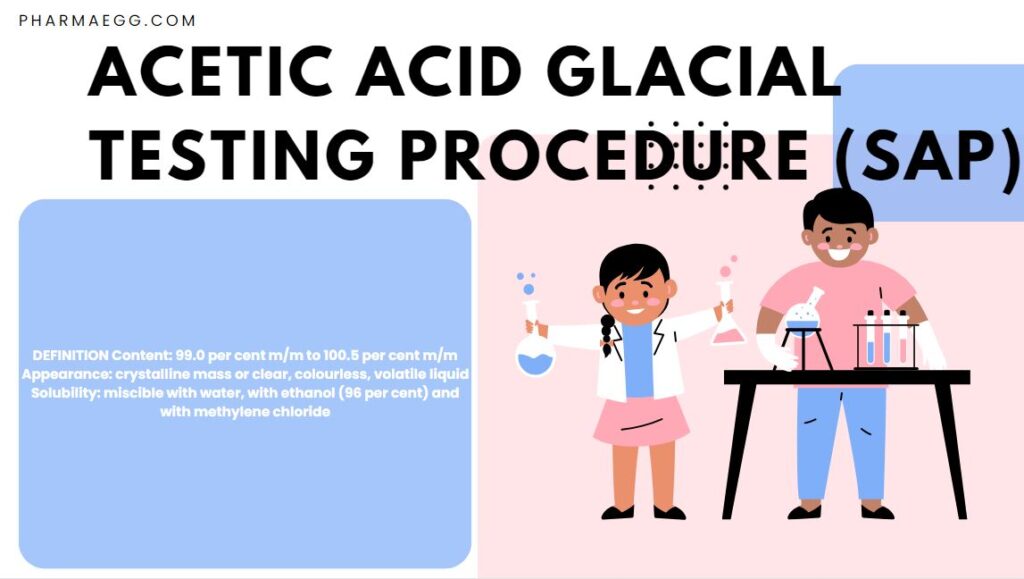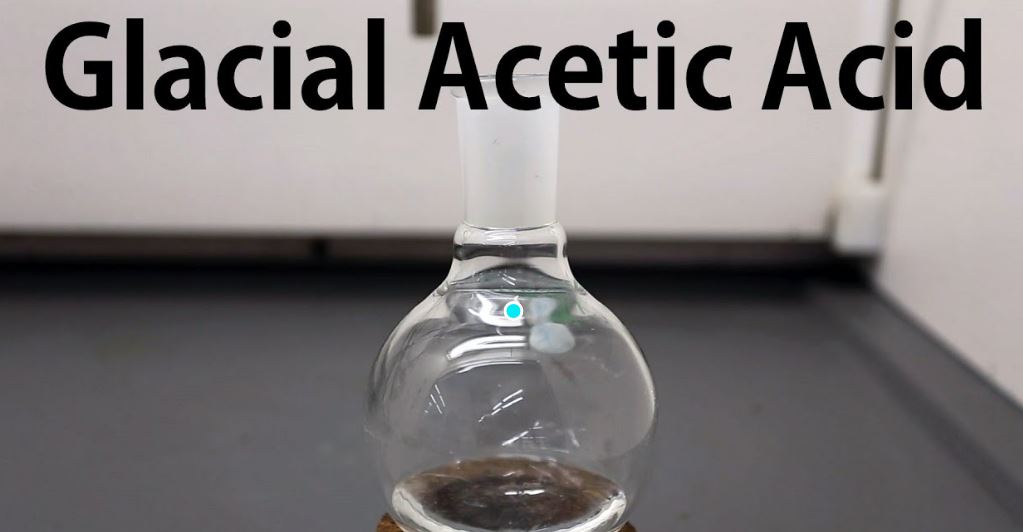
The term “SAP” in the context of acetic acid glacial testing likely refers to the “Saponification Value” or “Saponification Acid Value.” The Acetic Acid Glacial Testing Procedure (SAP) saponification value is a measure of the average molecular weight of all the fatty acids present in a substance. It is often used in the analysis of fats and oils. Here’s a general procedure for determining the saponification value of acetic acid glacial:
PURPOSE
SCOPE
RESPONSIBILITY
- Quality Control Manager
- Asst. Quality Control Manager
- Analyst
- Lab Assistant
PROCEDURE
- Analytical balance
- Glass Wares
- Silica crucible
- Hot plate
- Desiccator
- Burette
- Hot plate
Sr. # |
Name |
| Chemicals | |
| 1 | Distilled Water |
| 2 | Ethanol 96% |
| 3 | Chloroform |
| Reagents | |
| 1 | Lead standard solution 1 ppm |
| 2 | Acetate buffer pH 3.5 |
| 3 | Thioacetamide reagent |
| 4 | Chloride standard solution 5 ppm |
| 5 | Nitric acid 2M |
| 6 | Silver nitrate R2 solution |
| 7 | Barium chloride solution 25 % |
| 8 | Sulphate standard solution 10 ppm |
| 9 | Acetic acid 5M |
| 10 | Citric acid 20 % w/v |
| 11 | Ammonia 10 M |
| 12 | Iron standard solution 1 ppm |
| 13 | Sulphuric acid 6M |
| 14 | Potassium dichromate VS 0.0167 M |
| 15 | Potassium iodide (freshly prepared solution) |
| 16 | Sodium thiosulphate VS 0.1M |
| 17 | Starch mucilage solution |
| 18 | Sodium hydroxide VS 1M0 |
| 19 | Phenolphthalein solution |
Physical Analysis
Test of Physical Form:
Test of Colour:
Test of odour:
Test of solubility:
Test of Residue on evaporation:
Limit Tests:
Chlorides:
Sample:
- a) Dilute 5 ml of liquid to produce 100 ml with water.
- b) To 15 ml above solution add 1 ml of 2M nitric acid.
- c) Pour 1 ml of silver nitrate R2 solution in (a).
- d) Allow to stand for 5 minutes.
Standard preparation:
- Mix 10 ml chloride standard solution (5 ppm) with 5 ml of distilled water.
- Add 1 mL of silver nitrate to the mixture as an addition to R2.
- Allow to stand for 5 minutes
Heavy Metals:
- Evaporate 3.4 gm of sample to dryness and dissolve the residue in 20 ml of water.
- Take 12 ml of above solution and add 2 ml of Acetate buffer pH 3. 5 and mix.
- Add 1.2 ml of thioacetamide reagent mix immediately and allow to stand for two minutes.
- Mix 10 ml of 1 ppm lead standard solution with 2 ml of above sample solution being examined.
- Add 2 ml of acetate buffer pH 3.5 and mix.
- Add 1.2 ml of thioacetamide reagent. Mixed immediate then allow stand for two minute.
- Mix 10 ml of distilled water with 2 ml of prescribed solution.
- Mix 10 ml of 10 ppm lead standard solution with 2 ml of prescribed solution being examined.
- Add 2 ml of acetate buffer pH 3.5 and mix.
- Add 1.2 ml of thioacetamide reagent. Mixed immediate then allow stand for two minute.
- None of the brown colors produced in the sample are more severe than the standard
- The standard solution exhibits slightly brown colour when compared to blank.
Sulphate
- Take 12.5 ml of solution S used in diluted to 15 ml with water chloride.
- Add 1 ml of 25 % W/V solution of barium chloride to 1.5 ml of sulphate standard solution (10 PPM SO4) Shake and allow to stand for one minute.
- Add 15 ml of solution prepared in Step (a) to the solution obtained in Step (b).
- Add 0.5 ml of 5M Acetic Acid in and allow to stand for 5 minutes.
Reducing Substance:
Acetic Acid Glacial Testing Procedure (SAP)

Chemical Analysis:
- Strongly acidic, even when diluted free. (can be tested by using pH meter).
- When diluted with water and neutralized, Heat the substance being examined with an equal quantity of oxalic acid acidic vapous with the characteristic odour of acidic acid are evolved.
Contents of Glacial Acetic Acid:
Acetic Acid Glacial Testing Procedure (SAP)
Sample Preparation:
Accurately weigh a conical flask with a ground glass stopper containing 25 ml of water R. Add 1.0 ml of the substance to be examined and weigh again accurately. Add 0.5 ml of phenolphthalein solution R and titrate with 1 M sodium hydroxide.
1 ml of 1 M sodium hydroxide is equivalent to 60.1 mg of C2H4O2.
- Volume of 1M sodium hydroxide used = P ml
- Volume consumed = Q ml
- Exact molarity of sodium hydroxide after standardization = M
- Note the readings.
Quality Record(s)/Form(s)
| Required Record | Form Reference No. |
| GIR Acetic Acid Glacial Testing Procedure (SAP) | PPC/IV/000 |
| GRN Acetic Acid Glacial Testing Procedure (SAP) | PPC/IV/000 |
| Raw Material Analysis Sheet | SOR/QCD/RM/00 |
| Raw Material Q. C. No Register | SOR/QC/RM/0 |

